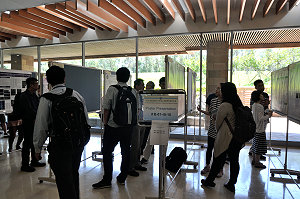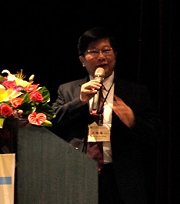NHRI Communications

會議報導
106年度國家衛生研究院生物醫學學術研討會紀實
Report on 2017 Biomedical Research Symposium of National Health Research Institutes
 106年度國家衛生研究院生物醫學學術研討會(2017 Biomedical Research Symposium of NHRI)已於8月14日至15日假本院會議中心舉行。今年度會議依往例規劃2場特別演講(plenary lecture)及6場專題演講,邀請國內外學者專家、執行成果優良之計畫主持人、本院研究人員及年輕研究學者口頭報告分享研究成果與經驗。本次會議參加人員包含院外計畫學術審查之國內、外專家近55位共同與會外,另有整合性計畫研究人員、本院研究人員及國內各機構研究人員355位報名與會,總計近四百人次與會,可謂盛況空前,充分達到學術交流之目的。
106年度國家衛生研究院生物醫學學術研討會(2017 Biomedical Research Symposium of NHRI)已於8月14日至15日假本院會議中心舉行。今年度會議依往例規劃2場特別演講(plenary lecture)及6場專題演講,邀請國內外學者專家、執行成果優良之計畫主持人、本院研究人員及年輕研究學者口頭報告分享研究成果與經驗。本次會議參加人員包含院外計畫學術審查之國內、外專家近55位共同與會外,另有整合性計畫研究人員、本院研究人員及國內各機構研究人員355位報名與會,總計近四百人次與會,可謂盛況空前,充分達到學術交流之目的。本次會議邀請中國醫藥大學副校長王陸海院士及美國加州大學爾灣分校生物醫學工程學系李伯晃教授擔任大會特別演講講員。會議首日上午由本院余幸司代理院長主持開幕,隨後由王陸海院士以「Regulation of breast cancer progression and metastasis by tumor microenvironment 註1」為題發表演說;次日上午則由李伯晃教授以「Microfluidic intervention of the circulatory system 註2」為題發表演說。
6場專題演講主題分別為:「Molecular genetics and medicine」、「Neural science」、「Biomedical science」、「Population health research」、「Cancer research」及「Medical engineering」,共邀請24位講員,於2個會場同步進行演講,分享其研究成果與經驗,促進學術交流及研究合作。

 囿於演講場次有限,本次會議另安排二個壁報時段(poster session),由整合性計畫主持人及本院研究人員張貼壁報展示研究成果(共計發表97篇壁報論文),並分組安排壁報論文討論會議(poster discussion),由各組會議主持人邀請部分壁報展示之研究人員簡短報告分享研究成果,以促進壁報發表者、計畫主持人、所有分組與會人員及學術審查委員間之討論與互動,除有助於委員瞭解計畫執行成效,亦能協助解決研究過程可能遭遇之困難。
囿於演講場次有限,本次會議另安排二個壁報時段(poster session),由整合性計畫主持人及本院研究人員張貼壁報展示研究成果(共計發表97篇壁報論文),並分組安排壁報論文討論會議(poster discussion),由各組會議主持人邀請部分壁報展示之研究人員簡短報告分享研究成果,以促進壁報發表者、計畫主持人、所有分組與會人員及學術審查委員間之討論與互動,除有助於委員瞭解計畫執行成效,亦能協助解決研究過程可能遭遇之困難。在2天的學術活動中,藉由演講、壁報論文展示及分組討論會議等安排,引發熱烈討論及腦力激盪,使與會人員獲益良多,且因交流互動增加,形成未來合作或團隊研究形成之可能,為國人之醫藥研究發展水準厚植潛力。
註1:王陸海院士特別演講摘要(演講內容請見國衛院電子報第712期「影音節目」)
 Title: Regulation of breast cancer progression and metastasis by tumor microenvironment
Title: Regulation of breast cancer progression and metastasis by tumor microenvironmentAbstract:
Triple-negative breast cancer (TNBC) is the most aggressive form among breast cancer subtypes. Accumulating evidence points to the important role of tumor microenvironment in the regulation of cancer progression and metastasis. Metabolic reprogramming including glucose metabolism is associated with progression of tumor growth. To identify the important players in such reprogramming, we employed 4T1/BALB/c syngeneic model to compare tumors of varying sizes. We identified the glycolytic enzyme transketolase (TKT) to be upregulated in the bigger tumors. TKT expression levels were the highest in lymph node metastases compared with primary tumor and normal tissues of patients. Reduced TKT attenuated TNBC cancer cell growth and metastatic behaviors. Depletion of TKT elevated the expression of alpha-ketoglutarate (α-KG), which upon injection into mice was able to inhibit tumor growth and metastasis. Reduced TKT or addition of α-KG switched glucose metabolism from glycolysis to TCA cycle through the regulation of enzymes involved in those pathways. These results suggest that TKT-mediated α-KG signaling pathway may be exploited for anti-metastasis therapy in breast cancer.
In addition, we found that the expression of CD24, a glycosylphosphatidylinostol (GPI)-anchored cell surface molecule, was elevated in highly lung and lymph node metastatic TNBC cells. Depletion of CD24 reduced primary tumor growth, lymph node and lung metastasis, as well as decreased blood and lymphatic vessels in tumor microenvironment. Knockdown of CD24 impaired EGFR/c-Met-mediated signaling and reduced lymphangiogenesis and angiogenesis-related molecules including VEGFA and VEGFC, via promoting EGFR and c-Met degradation. Treatment with CD24 mAb reduced lung metastasis in orthotopic xenograft mouse model. Clinical analyses showed that CD24high was associated with TNBC recurrence and poor 5-year survival. Thus, CD24 could be a therapeutic target for CD24 positive TNBC.
註2:李伯晃教授特別演講摘要
 Title: Microfluidic intervention of the circulatory system
Title: Microfluidic intervention of the circulatory systemAbstract:
Over the last 25 years, microfluidics has gone from a nascent hype with tremendous expectations through a period of underachievement and disappointments, to the current state of steady investment and ever increasing solid confidence. In my opinion, microfluidics is entering its golden age as the technology has matured to the point that most of the risk in determining whether a technology can make it to become viable product lies in its application and business strategy, and not in the feasibility of the technology. For biomedicine, there are several promising clinical applications that are relying on microfluidics technologies as the enabling technology. Examples of these applications are liquid biopsy, single cell analysis, genotyping/sequencing, organ-on-a-chip, and cell-based therapy. From a holistic health stand point, biomedicine has the goal of maintaining the balance of the physiological functions, and the most basic physiological system is the circulatory system. Thus the most basic function is the transport of liquid (predominantly blood) through this system, and therefore sampling, processing, analyzing, and recapitulating these liquid fluids and its components is the utmost function of medicine, and this is where microfluidics is making profound impact.
In this talk, I will focus on two aspects of using microfluidics to probe and process the circulatory system. The first is related to liquid biopsy, where my lab is developing technology to process blood and separate, enrich and analyze blood and its constituents. This advent of microfluidic liquid biopsy provides an in vitro snap shot into the patient’s physiological status via the in vivo circulation that enables one to monitor disease state and progression for diagnosis and prognosis. Liquid biopsy has become a promising technology to isolate and target rare cells such as circulating tumor cells (CTCs) in body fluids thanks to many of these microfluidic cell sorting techniques. The second technology that I will highlight from my lab is related to the development of microphysiological systems and organ-on-a-chip for drug screening and regenerative medicine. Over the years, drug screening has mostly been carried out on 2D monolayers in microwell plates and the drugs screened are not delivered through blood vessels as they are for in vivo treatments. Through the advancement of microfluidics technologies, and in collaboration with two of my colleagues, our team has developed a perfused vascularized 3D micro tissue, with drugs or biological fluids delivered through microfluidic channels that are “anastamosed” with the capillary network in the micro tissue. This vascular network mimics the physiological circulation of the human body on-chip. The critical bottleneck is to engineer the microenvironment for the formation of 3D tissues and organs and to also pump and perfuse the tissue vascular network for on-chip in vitro microcirculation. Microfluidics play an important role in both the above-mentioned in vivo liquid biopsy and in vitro physiological circulation platforms. These two technologies will go hand-in-hand to connect in vitro screening to in vivo treatment with tremendous potential towards the realization of personalized medicine.
《文/圖:學術發展處蕭振祥》